Pingdom
Pingdom is an application performance monitoring tool that tracks the availability and performance of websites. When state changes to your uptime or transaction checks occur, this integration with xMatters relays critical insight data to the correct people and systems to help them coordinate and resolve incidents faster.
This workflow lets you send actionable alerts to on-call resources when xMatters gets a signal from Pingdom. Responders can initiate an incident with the press of a button, or you can build on the flow to perform automated resolution tasks.
How it works
When a state change is detected in Pingdom, it sends a JSON-formatted webhook to xMatters. A Pingdom Check Alerts trigger in xMatters parses the webhook and initiates a flow. The webhook includes essential alert data you can use to enrich notifications to users or when building automated tasks.
Install the workflow
The following instructions describe how to install the workflow through the xMatters one-click installation process. If you already installed the previous, built-in version of the integration, you can find instructions here.
- Go to the Workflow Templates page and click the Pingdom tile.
- On the Set up the Workflow tab, give the workflow a name that identifies its purpose (this must be unique in your instance), add an optional description, and set the default incident type (if applicable). Any built-in Initiate Incident steps in the workflow will automatically be set to the selected incident type.
- You can edit these later, if needed.

- You can edit these later, if needed.
- Click Next to set up the connection.
- Choose the authentication method. A trigger URL is generated based on the selected authentication method.
- Copy the trigger URL — you’ll use this to configure the webhook in Pingdom.
- The trigger URL includes the recipients parameter, which specifies who should be notified. By default, this parameter is set to notify you (the logged in user), but you can set it to target any user or group you want.
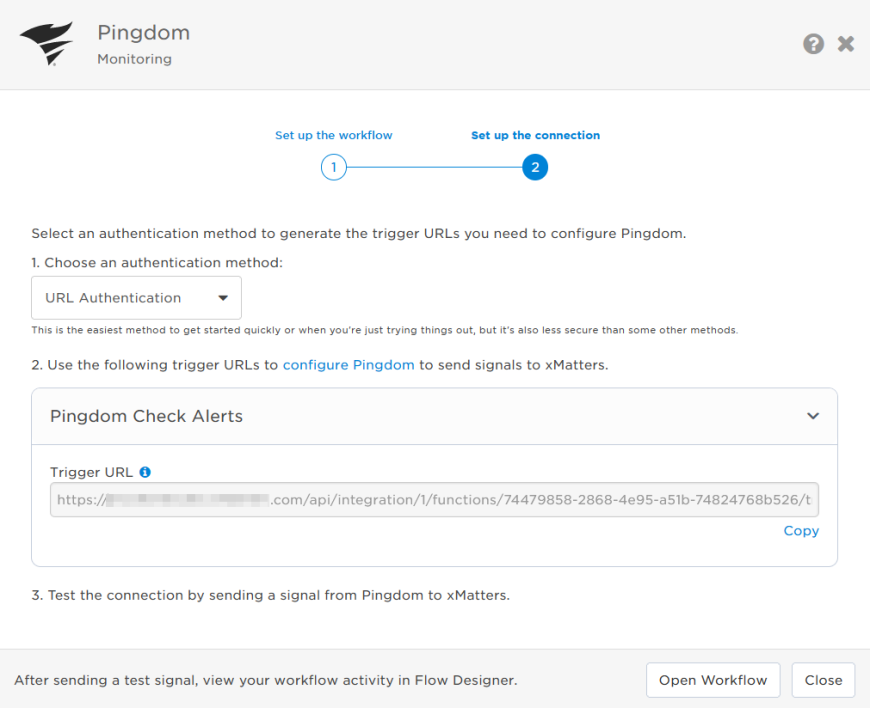
- The trigger URL includes the recipients parameter, which specifies who should be notified. By default, this parameter is set to notify you (the logged in user), but you can set it to target any user or group you want.
- Send a test signal to the trigger URL to test the connection.
- Click Open Workflow to view and customize the workflow, or Close to return to the Workflows page.
Configure Pingdom to send requests to the trigger URL
To have Pingdom send alerts to the flow trigger, you need a check and an integration. The check determines if something is wrong. The integration is the webhook that notifies xMatters.
- In Pingdom, select Integrations from the menu bar, then click Add integration.
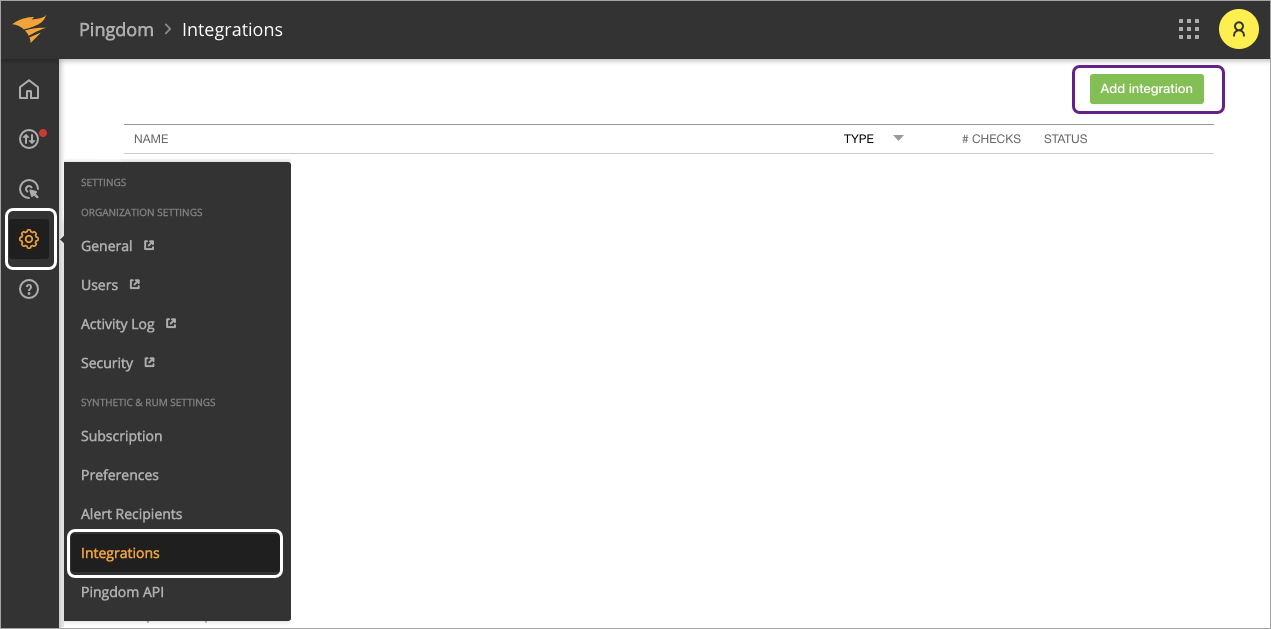
- In the Add Integration window, fill in the following fields:
- Type: Webhook
- Name: Give your integration a unique, descriptive name.
- URL: If you use URL Authentication, paste the URL you copied from the Pingdom Check Alerts trigger in Flow Designer.
- If you choose to use Basic authentication, you need to add your username and password to the URL in the following format:
https://<username>:<password>@<company>.xmatters.com/api/...
For example, a basic authentication link would look like this:
https://mmcbride:MyPassWord1234@mycompany.xmatters.com/api/..../triggers?recipients=mmcbride - Add the target names of any recipients you want to notify when the alert fires to the end of the URL.
- For URL authentication, use an ampersand to attach recipients. For example, if you want to notify Emma Pearson and the on-call members in the group responsible for the Antares service, you'd add &recipients=epearson,antares to the URL.
- For other authentication types, use a question mark to attach recipients. For example, if you want to notify Barry Gull and the on-call members in the group responsible for the Cassiopeia service, you'd add ?recipients=bgull,cassiopeia to the URL.
- You must URL-encode any special characters or spaces in the target names.
- If you choose to use Basic authentication, you need to add your username and password to the URL in the following format:
- Active: Ensure the check box is selected.
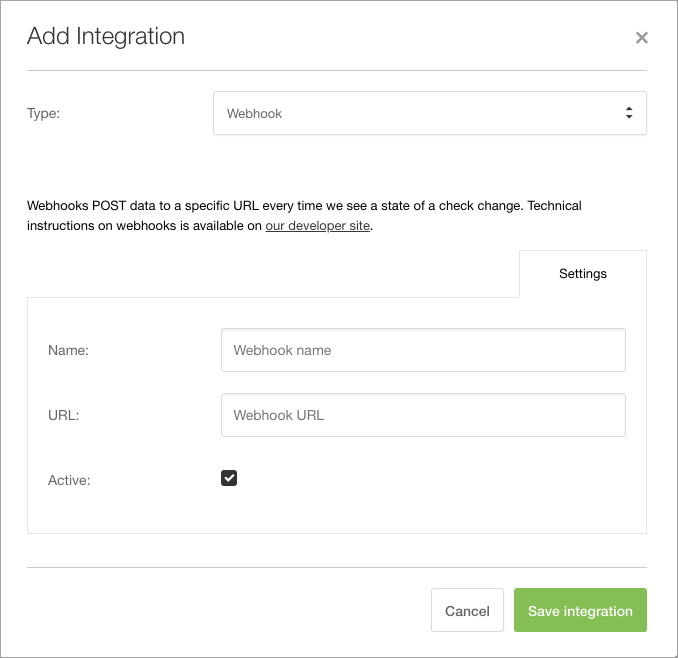
- Click Save integration.
You're ready to use the webhook to trigger automated flows, including steps such as sending alerts and initiating incidents, though we always recommend testing before putting things into use.
The workflow includes a "Test" flow path that you can use to check whether you've successfully configured the Pingdom integration to send signals to your trigger in xMatters.
To test your webhook:
- In Pingdom, click Synthetics in the main menu, then select Uptime.
- Find your check in the list, then select Edit from its drop-down menu.

- Scroll to the bottom of the Edit Check dialog window, and in the Webhook section, click Test next to the name of your integration.

- In xMatters, on the Flow Designer tab of your workflow, click the name of the Pingdom Check Alerts canvas to open it.
- Click Activity in the top right corner of the canvas.
- In the Activity panel, click the name of the Pingdom Check Alerts trigger.
- If your trigger is properly configured in Pingdom, the test request executed successfully.
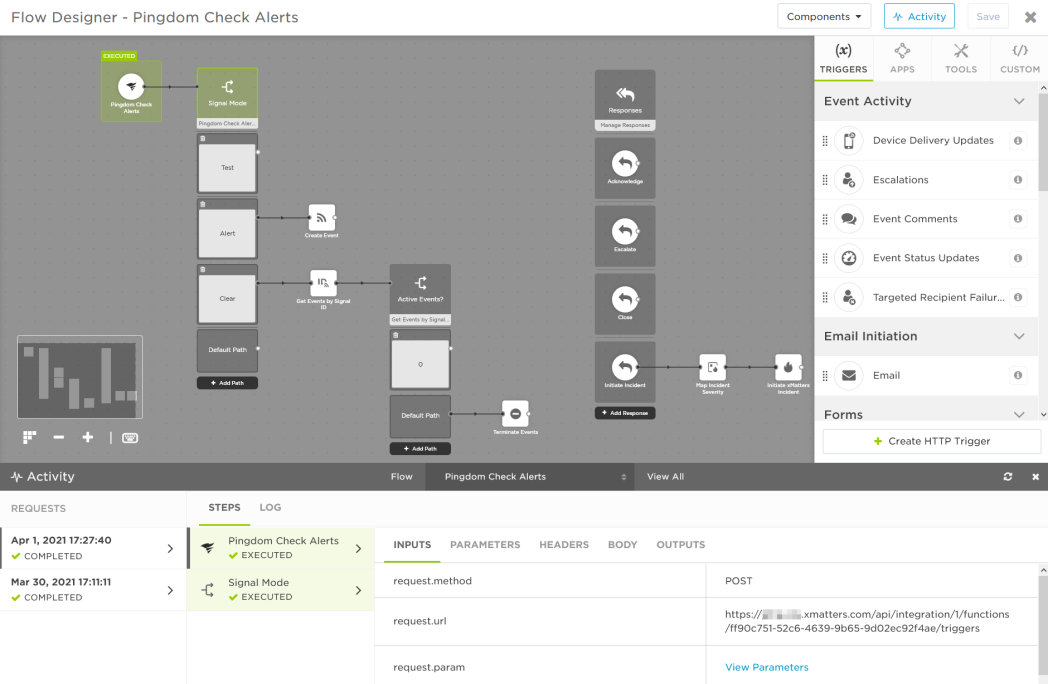
Set recipients in the trigger URL
The trigger expects the recipients in the trigger URL. When you copy the URL from xMatters, it includes the recipients parameter: recipients=<yourname>. Of course, you don’t want to receive all the alerts.
To change the recipients for alerts from this webhook, swap out your name for the people or groups you want to target.
- For URL authentication, use an ampersand to attach recipients. For example, if you want to notify Emma Pearson and the on-call members in the group responsible for the Antares service, you'd add &recipients=epearson,antares to the URL.
- For other authentication types, use a question mark to attach recipients. For example, if you want to notify Barry Gull and the on-call members in the group responsible for the Cassiopeia service, you'd add ?recipients=bgull,cassiopeia to the URL.
Remember to URL-encode any special characters, including spaces, in your group names.
We recommend using groups so you can take advantage of the xMatters group features — rotations, escalations, and absences — to reach the right on-call people to jump on an issue.
How to use the workflow
When a check you've created fires, it sends a signal to xMatters, which creates an alert and notifies the individual or the on-call members of the people or groups you set as recipients in the webhook URL. When the trigger receives a signal saying the issue is resolved, it automatically terminates related alerts in xMatters.
The person responding to the notification has the following response options:
- Acknowledge: Acknowledges the notifications and stops escalations.
- Escalate: Immediately escalates the alert to the next on-call resolver in a targeted group.
- Close: Ends the xMatters alert and stops notifying all targeted recipients.
- Initiate Incident: Initiates an incident in xMatters.
Next Steps
Now that you've installed the workflow, you can use it as-is, or customize it to suit your needs better. Here are some examples of things you can add to the workflow to customize it:
Pingdom includes two importance levels for alert or transaction checks: High importance and Low importance.
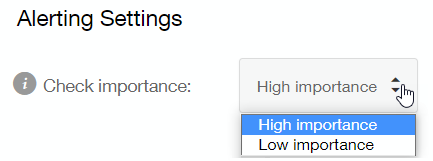
When a recipient selects the Initiate Incident response to the alert notification, this workflow initiates a 'High' or 'Low' severity incident in xMatters, corresponding to the importance level of the check in Pingdom:
- High importance: maps to 'High' incident severity in xMatters
- Low importance: maps to 'Low' incident severity in xMatters
You can change the severity level xMatters assigns when initiating the incident by updating which severity level each importance level maps to in the Map Incident Severity step. For example, you could map HIGH importance checks to 'Critical' and LOW importance checks to 'Minimal' incident severity levels in xMatters.
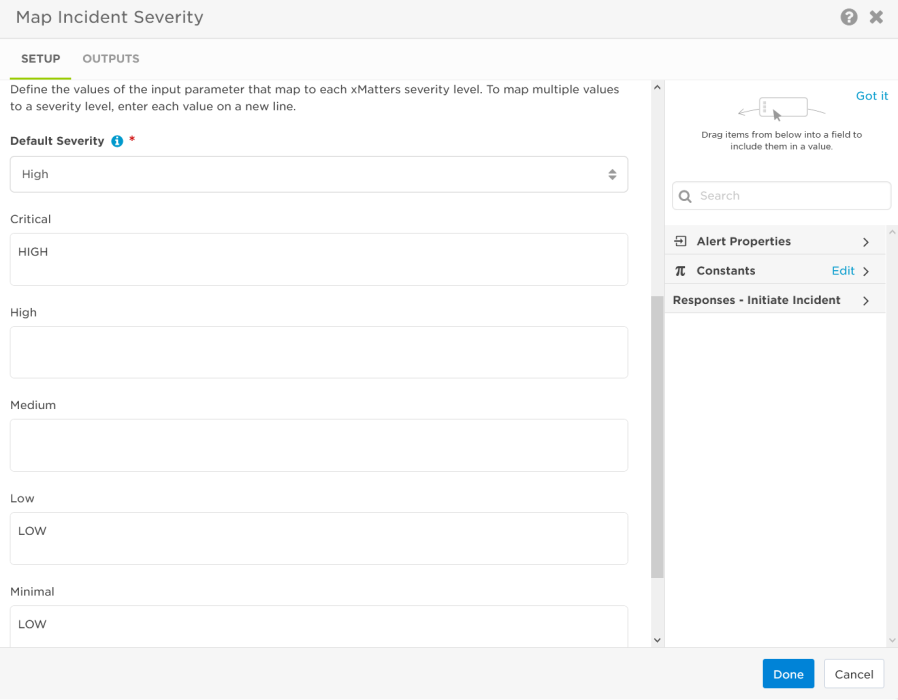
- Use Slack, Zoom, and Microsoft Teams steps to add collaboration channels to the flow.
- Update the message sent to resolvers to include the information most relevant to your team.
- Use the Pingdom Check Alerts trigger to build your own custom flows.
Previous versions
While the previous, built-in version of this integration is no longer available, the instructions for it are included below for anyone who has it installed in their system already.
Pingdom is a website monitoring service that tracks the uptime, downtime, and performance of websites. Pingdom state changes trigger xMatters notifications to automatically notify and engage your incident response teams.
xMatters automates communications by integrating people into your toolchains so you can proactively prevent outages, rapidly engage resolvers, manage major incidents, and keep stakeholders informed.
Do more with this integration
Incorporate this integration into your orchestrated incident resolution workflows with Flow Designer. After you create a configuration, the Flows tab appears. From there, you can build your flows — add new response options, connect to other apps, or even create new xMatters alerts based on activities in the flow — enriching the information injected by this integration along the way.
Get started with Pingdom
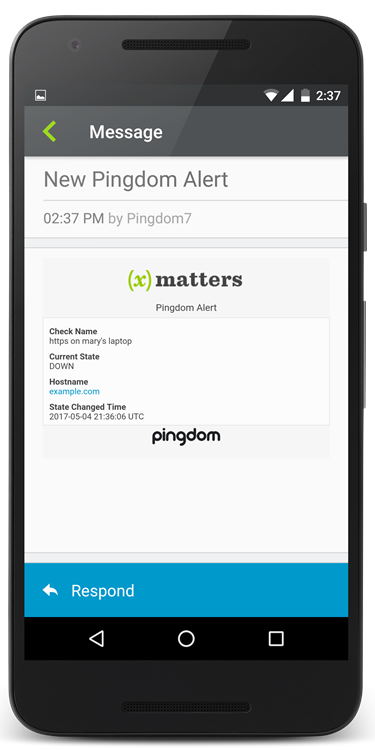
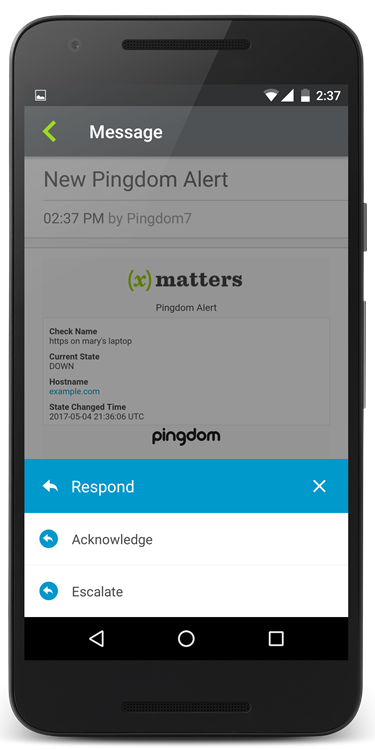
To install this integration in xMatters, simply go to Workflow Templates on the Workflows tab and start typing the name of the integration you're looking for to filter the list. Once you find it, click its tile then click Next to get to the configuration screen.
How to set up a Pingdom configuration
After you give your configuration a name and description, type a name to use when sending alerts (so you can easily tell which configuration or integration the alerts are from), and add all of the users and groups you want to be notified.

Once you save the configuration, xMatters displays the URL you need to configure Pingdom:

Use this URL to configure a new webhook integration in Pingdom.
- Log into your Pingdom account.
- On the Pingdom menu, select Integrations > Integrations, and then click Add integration.
.png)
- In the Add Integration dialog box, select Webhook as the integration type and give it a unique name.
- Paste the URL from xMatters in the URL field.
- Click Save Integration.
_676x584.png)
After you've saved your webhook, you need to enable it for an uptime (HTTP) check in Pingdom.
- On the Pingdom menu, click Monitoring > Uptime.
- If you have an existing uptime check, click the name of your site.
- To create a new uptime check, click Add New. Give the check a descriptive name and provide the URL of the website you want to monitor.
- In the list of webhooks, use the check box to enable your webhook.
- Click Create Check or Modify Check to save.
_672x585.png)
Your integration is now complete!
Test your integration
You can test the integration by sending a test webhook from Pingdom to xMatters.
- On the Pingdom menu, click Monitoring > Uptime.
- Click the name of your site to open the Edit Check dialog box.
- Click the Test button for your webhook to trigger your xMatters integration.
_731x415.png)
Check out the screenshots at the top of this page to see what the notifications would look like in the xMatters mobile app.
Extending your integration
Looking to do more with xMatters and Pingdom? If you want to tailor the settings and notifications for the integration, you can convert it to a custom workflow.
